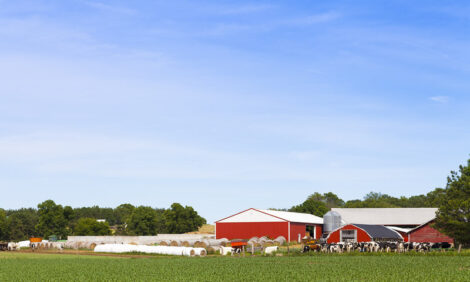



Keep Silage Intake High to Avoid Yield Losses
UK - Many UK dairy farmers will have to drive silage feed intake this year on account of first cut crops being low in metabolisable energy (ME) and dry matter.This is if a yield drop of 0.8 litres per head per day is to be avoided, says Trouw Nutrition after its latest forage analysis results.
High covers and a wet spring resulted in delayed cutting and forage high in structural fibre but lower in energy density, Trouw Nutrition Ruminant Manager Adam Clay told the Livestock event yesterday.
“It is like the opposite of last year, we are seeing high volume silage but lower quality,” he said. “Intake potential of first cut silage is low and this is very difficult to lift.”
The Importance of Forage Intake
Based on 1400 samples analysed this year, Mr Clay advised that an extra 4.1 kilos of fresh weight silage per day would be required to achieve the same dry matter intake as in 2013.
And due to ME being lower, a further 0.4 kilos could be required.
He also warned of the implications of less structural fibre in the rumen.
“Wetter forage means we have less structure to create a rumen mat to stabilise rumen function.
The good side is that a pH of below 4.1 and higher sugars should mean good fermentation and stability in the clamp.”
Improving Intake
Nutritionist Mark Scott of KW Alternative Feeds told TheDairySite that moist feeds were one option for driving forage intake.
He added that liquids such as Mollasses could be added to not only improve palatability of forage, but also to drive the biology of the rumen.
“Early indication would be that this year requires driving intake of forage and getting the balance right. Moist feeds can be excellent dry feed replacers,” said Mr Scott.
“A healthy rumen will be vital as cows will probably have to process more feed.”
He added that falling cereal prices could offer options if silage is fibrous and keeping the rumen healthy.
“Fibre helps keep rumen pH up so more maize, cereal, biscuit meal can be fed,” explained Mr Scott. “This will allow for cow energy levels to be maintained.”
Mr Scott stressed that ensuring energy intake is key otherwise fertility and milk protein content could suffer.
Another milk component to watch for is Butterfat - this could be pushed up by fibrous silage.
He said: “If you have some more fibrous silage that is dry and not acidic you may see a little rise in Butterfat levels.”
Management Steps
Simple management practices could make all the difference in ensuring cows get through enough feed, according to Roy Eastlake, national technical support manager for Biotal.
He suggested ‘pushing up’ feed more often and a better consistency of mixing to ensure.
He said: “There is a lot of silage around this year and the clamps are bulging. Mollasses could be used to stimulate forage intakes and mixed forage diets can also stimulate dry matter intake.
“Clean feed troughs also help. It sounds simple but some farmers sometimes neglect these management practices.”
With quantity of first cut silage high and quality low, Mr Trouw’s Adam Clay said that the best second cuts will probably be cut earlier and made of young fresh grass.
“Another management factor is to consider chop length as a reduction in chop length will drive dry matter intakes higher,” he added.
He concluded that selection is the biggest ‘scurge’ of total mixed rations.
Michael Priestley
News Team - Editor
Mainly production and market stories on ruminants sector. Works closely with sustainability consultants at FAI Farms



